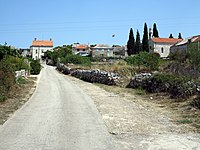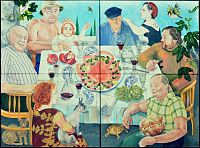Srednje Selo (Šolta)
| Srednje Selo | ||
|
|
||
| Basic data | ||
|---|---|---|
| State : |
|
|
| County : |
|
|
| Island : | Šolta | |
| Height : | 182 m. i. J. | |
| Residents : | 161 (2011) | |
| Telephone code : | (+385) 021 | |
| Postal code : | 21430 Grohote | |
| License plate : | ST | |
| Structure and administration (as of 2017) |
||
| Community type : | Village | |
| Mayor : | Nikola Cecić-Karuzić (candidate Grupe Birača) | |
| Postal address : | Podkuća 8 Grohote |
|
| Website : | ||
Srednje Selo , the middle village , is a farming village on the island or municipality of Šolta in the Croatian Split-Dalmatia County in the Adriatic opposite Split west of Brač . Srednje Selo belongs to Grohote and has 104 inhabitants.
geography

Srednje Selo, the middle village, is connected to the mainland (Split) by car ferries and catamaran ferries via Rogač or Stomorska . It is 1.6 km from the island's main town, Grohote . Buses to Srednje Selo run from the Rogač ferry port. The surrounding area belongs to the place.
Srednje Selo is located on the northern edge of the fertile Donje polje field, the lower field . The upper field is that of Gornje Selo , where the richest farmers lived. Due to its location on a south-facing slope, the village is protected from the north wind ( bora ), lies in the sun and is at the same time open to the cooling winds coming from the south-west.
An old road leads from the center of the village to the neighboring villages of Donje Selo and Grohote . The state road D111 passes the towns in the south.
economy
Srednje Selo is a simple farming village with no tourism. Farmers and fishermen live in the village.
history


A first written record dates from 1446 as Villa de medio , where the inhabitants of Grohote had their stables. The women of Srednje Selo are called Srdovaška , which goes back to the Old Slavic or Croatian vas for village. The “middle place” was probably once called Srednje vas . As is usual on Šolta, one can assume that the place was already inhabited in ancient times. There are several archaeological finds in the neighboring village of Donje Selo near the corridors Bunje, Mirine and Studenac in the west and Pod Mihovil and Svilaja in the south. There are remains of farm buildings, graves, fragments of architectural sculptures and ceramic shards. Many ancient finds from the island are exhibited in the Archaeological Museum in Split .
The village, which is typologically similar to the other island villages and whose roots go back to the Middle Ages, is located on the mountainside on the edge of the fertile plain. The houses, criss-crossed by winding alleys, are relatively close to one another. Because of the danger of pirates, the courtyards were always enclosed by stone walls and apart from the main entrance on the ground floor they had no opening. Since Šolta was in the border area between the Ottoman Empire and the Republic of Venice , the danger of looting and raids, especially by the pirates of Omiš, was great, which is why there were only places in the interior of the island for centuries. However, there was no real protection without fortress towers.
The island of Šolta was owned by the Split nobility and the Catholic Church from the 14th century to 1905 . The proximity to Split made the island an important supplier of wood, lime, meat, fish, oil, wine, almonds, carob , figs and honey. The residents were not free farmers, but tenants of the land. At the time of the Austro-Hungarian monarchy , the place is listed in the administration until 1918 with the Italian name Villa Media .
The multi-storey houses are around 100 to 120 years old. It was built mostly with the money of the emigrants who supported the families at home. The building quality of the houses is usually not good. There was not enough good oak wood for the roof trusses, which had to be particularly strong as stone slabs were used to cover them. Due to the high costs, only a few houses are restored, but they prefer to build new ones. Today the majority of the houses in Donje Selo have fallen into disrepair and collapsed. The reason is unclear property relations due to massive emigration and the failure to distribute inheritance or payment of claims, especially during the time of the communist People's Republic of Yugoslavia , where there was also a constant danger of expropriation. Descendants of emigrants keep coming to the islands to look for their roots. An extensive work with the pedigrees of the old families is available from the tourist information. Lukana dvor and Purtića dvor are particularly picturesque courtyards. In an old courtyard there is still an antique grape press.
On the south-eastern edge of the village is the Catholic parish church of Mariä Lichtmess (Kandelora), built in the neo-Romanesque style , which is considered one of the most beautiful on the island. It was built from 1882 to 1895 on the site of an older church from the 17th century. Like other church squares on the island, it is probably very old. A fragment of an early Christian sarcophagus was also found here . The main architect of the church is Emil Vecchietti, at that time the most famous architect in the region. He was probably supported by the architect Ante Bezić, son of the mayor of Grohote and head of Šolta. Vecchietti and Bezić also worked together at the Split theater. Bezić also planned the facade of the Franciscan monastery and bell tower on the shore in Split. Seven typologically different marble altars come from the stonemasonry of the famous Split altar builder Pavle Bilinić, whose daughter was Vecchietti's wife. The altarpiece "Presentation in the Temple" from the second half of the 19th century was made by master Antonio Zuccaro from Trieste . A special feature of this church is that the wooden choir has been preserved, which the church choir sings about.
There is a memorial on the church square that commemorates the victims of the fascist . In 1941, during the Balkan campaign of the German National Socialists , Šolta was annexed by their Italian auxiliaries under the fascist Mussolini . The Italian coast is only about 200 km from Šolta. Some of the residents fought back and in the summer of 1942 founded a People's Liberation Committee. Brave men of the island fought as partisans against the occupiers. But not all went into the resistance. Some collaborated with the Italians, others joined the Croatian fascists, the Ustasha . The consequences for the islanders were terrible. During the Second World War 1,825 citizens were expelled from Šolta. 939 were deported more or less voluntarily to El Shatt on Sinai at the southern end of the Suez Canal in Egypt . In the final phase of the war not a single inhabitant lived on the island for over six months.
Demographics
The population development corresponds to the trend of the island. The villages in the interior of the island are losing inhabitants, while the places on the coast are growing.
| Population development from 1857 to 2011 | |||||||||||||||
|---|---|---|---|---|---|---|---|---|---|---|---|---|---|---|---|
| 1857 | 1869 | 1880 | 1890 | 1900 | 1910 | 1921 | 1931 | 1948 | 1953 | 1961 | 1971 | 1981 | 1991 | 2001 | 2011 |
| 256 | 325 | 316 | 355 | 394 | 372 | 324 | 309 | 321 | 308 | 285 | 206 | 143 | 150 | 128 | 104 |
Personalities
- Maja Ettinger-Cecič (* 1962, Srednje Selo), painter living in Vienna
literature
- Joško Belamaric: Island of Šolta. (Library of Tourism and Heritage. No. 82). Zagreb 2011, ISBN 978-953-215-697-3 .
- Mladen Andreis: Stanovništvo otoka Šolte do godine 1900. Šolta, Opcina 2011, ISBN 978-953-55249-1-5 [1] .
Web links
- Općina Šolta: Šolta Općina Šolta. Retrieved on August 13, 2019 (Croatian, official website of the municipality of Šolta).
- Ferry times
Individual evidence
- ↑ Republic of Croatia: Popis 2011. Census of Population, Households and Dwellings 2011, First Results by Settlements (PDF; 2.5 MB), Zagreb 2011.
- ↑ Zoran Civadelić, Zoran Bursac: Welcome to Srednje Selo! ( Memento from February 9, 2014 in the Internet Archive )
- ^ Belamaric: Island of Šolta. Zagreb 2011, p. 30.
- ↑ Split Archaeological Museum | German
- ↑ Stermich (Segretaria di Governo): AVVISO No. 24979-9466. In: Gazzetta di Zara / Gazzetta di Zara. Foglio Ufficiale (d'Annuncii / d'Annuzi) della Gazzetta di Zara , February 2, 1841, p. 12 (online at ANNO ). , accessed on September 3, 2019 (Italian, price list for cadastral extracts)
- ↑ Mladen Andreis: Stanovništvo otoka Solte do godine 1900's.
- ^ Belamarić: Island of Šolta. Zagreb 2011, p. 17.
- ↑ - Republika Hrvatska - Državni zavod za statistiku: Naselja i stanovništvo Republike Hrvatske 1857-2001. ; Republic of Croatia: Popis 2011. Census of Population, Households and Dwellings 2011, First Results by Settlements. (PDF; 2.5 MB), Zagreb 2011.



